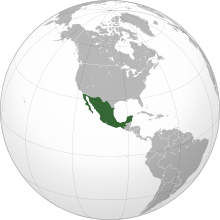Mexico
From Wikipedia, the free encyclopedia
The United Mexican States[9] (Spanish: ![]() Estados Unidos Mexicanos (help·info)), commonly known as Mexico (English: /ˈmɛksɪkoʊ/) (Spanish:
Estados Unidos Mexicanos (help·info)), commonly known as Mexico (English: /ˈmɛksɪkoʊ/) (Spanish: ![]() México (help·info) [ˈmexiko]), is a federal constitutional republic in North America. It is bordered on the north by the United States; on the south and west by the Pacific Ocean; on the southeast by Guatemala, Belize, and the Caribbean Sea; and on the east by the Gulf of Mexico.[10][11] Covering almost 2 million square kilometres,[12] Mexico is the fifth-largest country in the Americas by total area and the 14th largest independent nation in the world. With an estimated population of 111 million,[13] it is the 11th most populous country. Mexico is a federation comprising thirty-one states and a Federal District, the capital city.
México (help·info) [ˈmexiko]), is a federal constitutional republic in North America. It is bordered on the north by the United States; on the south and west by the Pacific Ocean; on the southeast by Guatemala, Belize, and the Caribbean Sea; and on the east by the Gulf of Mexico.[10][11] Covering almost 2 million square kilometres,[12] Mexico is the fifth-largest country in the Americas by total area and the 14th largest independent nation in the world. With an estimated population of 111 million,[13] it is the 11th most populous country. Mexico is a federation comprising thirty-one states and a Federal District, the capital city.
In Pre-Columbian Mesoamerica many cultures matured into advanced civilizations such as the Olmec, the Toltec, the Teotihuacan, the Maya and the Aztec before the first contact with Europeans. In 1521, Spain conquered and colonized the territory, which was administered as the viceroyalty of New Spain which would eventually become Mexico as the colony gained independence in 1821. The post-independence period was characterized by economic instability, territorial secession and civil war, including foreign intervention, two empires and two long domestic dictatorships. The latter led to the Mexican Revolution in 1910, which culminated with the promulgation of the 1917 Constitution and the emergence of the country’s current political system. Elections held in July 2000 marked the first time that an opposition party won the presidency from the Institutional Revolutionary Party (Spanish: Partido Revolucionario Institucional, PRI).
As a regional power[14][15] and the only Latin American member of the Organisation for Economic Co-operation and Development (OECD) since 1994, Mexico is firmly established as an upper middle-income country,[16] considered as a newly industrialized country[17][18][19][20] and has the 13th largest nominal GDP, the 11th largest by purchasing power parity, and also the largest GDP per capita in Latin America according to the International Monetary Fund.[21] The economy is strongly linked to those of its North American Free Trade Agreement (NAFTA) partners[22][23] Uneven income distribution and the increase in drug-related violence are issues of concern in Mexico.[24]






